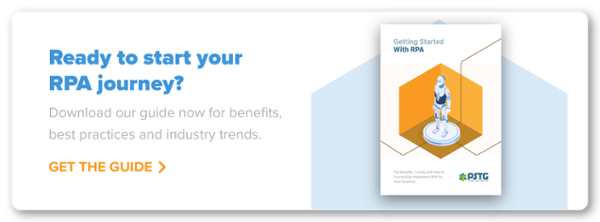Difference Between RPA and AI and Which Reigns Supreme?

Before we compare the two, here’s a quick reminder of exactly what Robotic Process Automation (RPA) and Artificial Intelligence (AI) are. AI is concerned with “thinking” and machine learning whereas RPA is fundamentally associated with “doing.”

They’re both valuable tools which you can use to aid your business' digital transformation and growth. But are they even competing? Let’s discuss.
- Which Reigns Supreme?
- AI - The Thinker
- RPA - The Doer
Which Reigns Supreme?
It’s important to realise that it’s not as simple as saying AI vs RPA, as they’re both on the spectrum of Intelligent Automation (IA). As a whole, IA works with staff to streamline processes, boost productivity and ensure you spend money efficiently.
When we break it down into RPA and AI, both help you to automate tasks so your staff can spend more time working on more important projects.
The choice between implementing RPA or AI (often both), depends entirely on your specific requirements. Ensuring a solution is right for your stage in the IA journey is essential.
Where RPA would be perfect for basic data entry, you might need sophisticated AI to analyse an email and determine what should happen next. If you only had RPA in place, your team would still need to do the intelligent thinking and if you only had AI, you’d get the smart recommendations but you’d still need to do the implementing.
This is why combining the two allows the automation process to begin much faster, creating an automation continuum. Often referred to as Intelligent Robot Process Automation (iRPA), their coexistence can only be a positive thing. The sooner you get started with RPA, the sooner you’ll reap the benefits of automation, from increased productivity and fewer human errors to gaining more time to spend on strategic business planning.
AI - The Thinker
From Tesla’s self-driving cars to the virtual assistant on your phone, it’s easy to forget just how much we already rely on AI for everyday life. The term was officially coined in 1956 but has become increasingly popular because of the advancements in computing power, algorithms and storage.
Whilst Hollywood depicts AI as robots taking over the world and replacing humans, the reality isn’t anywhere near as dramatic. AI, in real life, is about finding the best allocation of your resources to enhance your product and service offerings.
For example, in the healthcare sector, organisations are progressively adopting AI to improve patient care. Electronic health records (EHR) are crucial to the digitisation of the healthcare industry. However, logging all of this data comes with its own problems. EHR developers are now automating much of the process and even starting to use natural language processing tools to improve it.
A study conducted by the Centerstone Research Institute found that predictive modelling of EHR data has achieved 70% accuracy in predicting treatment response for each patient. Using an AI tool that scans EHR data can pretty accurately predict a patient’s disease course.
Machine learning is also a core part of AI. It learns from previous encounters and tailors them for future engagements. When machines become more intelligent, they understand, reason, observe and connect. This streamlines processes, making repetitive tasks obsolete but also using the data to make more intelligent decisions in the future.
The system could learn when appointments are most likely to be accepted or declined and spot trends for regular visitors. From this, it can suggest the most optimum slots to improve the efficiency of the process and also highlight possible opportunities for improvement.
The number of Consultant Radiologists hasn’t increased over the past 10 years and AI might be the solution. Machine learning algorithms exposed to large amounts of past diagnoses can tirelessly create new rules for classifying scans based on that alone.
It’s not just healthcare processes that AI can assist with. AI can free up monotonous tasks for marketing departments too.
For example, if you’re planning a new email marketing campaign, your AI assistant can make intelligent suggestions - without bias - based on previous data. RPA can work alongside AI to segment your customers, trying out different subject lines and copy variations and identifying hidden patterns you might not have noticed. This results in better targeted messaging and increased open rates, all with minimal input from the human marketer.
It’s thought that 37% of organisations have already implemented AI in one form or another. The upward trend of AI adoption is due to technological breakthroughs, an increase in possible uses and growing acceptance from consumers. Invest in these innovative technologies and your business can prosper and be ahead of the curve.
RPA - The Doer
A report by Transparency Market Research has shown that RPA is forecasted to see a compounded annual growth rate of 60.5% worldwide through 2020 due to it being the first step for many organisations who seek a more intelligent future.
RPA uses software that has been pre-configured with scripted activity, so it can autonomously execute a combination of tasks, transactions and processes.
Thanks to RPA's increased cognitive abilities, it means certain processes (such as menial, repetitive tasks that can often fill up your team's calendar) can be automated indefinitely. RPA’s ability to automate these consistent and routine processes - regardless of the time of day - is why it’s affectionately nicknamed the digital worker.
Whether it’s data entry into CRMs, payroll, updating inventory records and more, a digital workforce can manage these tasks efficiently. And while this software is taking care of these tasks, you and your team can focus on more strategic projects that are vital to business growth.
These are just a few examples of how bots and humans can collaborate for the benefit of the business. However, if you want to learn more about RPA and what it can streamline for you alongside AI, we have the perfect resource for you.
Download Your Guide to Get Started With RPA
To really use RPA to its maximum potential, you need to implement this software in the right way. In our guide, we’ve covered all the reasons why businesses should be seriously considering implementing RPA, the latest trends in IA and more.
To get your free copy, click on the link below.




